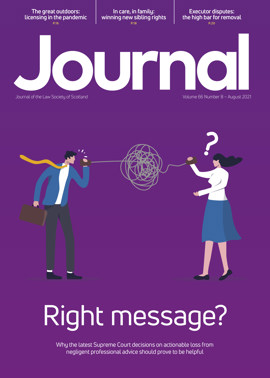Executor removal: a high bar

All executry practitioners will be conscious of the patience, tact and diplomacy required when dealing with bereaved clients and family members. Death can ignite or inflame painful and difficult family dynamics. When executors find it difficult or impossible to co-operate with each other, this can lead to stalemate in administering the estate.
Removal of an executor is a serious matter, requiring a petition to the Outer House. Two recent cases, both decided by Lady Poole, show the difficulties in persuading the court to take the extreme step of removing an executor due to ineffective and/or improper administration of an estate. Here we review the two cases, discuss the legal and practice issues arising, and consider the requirements for a successful action to remove an executor.
Campbell v Campbell [2021] CSOH 3
In this case the petitioner was one of the late James Campbell’s sons and a beneficiary under his will.
The respondents were the other son and his wife. The respondents had acted as attorneys for James Campbell during his lifetime and were also appointed his executors. As attorneys the respondents had provided Campbell with a great deal of assistance, and during that time and during the administration of his estate incurred expenses, which were reimbursed from the estate. They also made payments to their sons, which they averred were in implement of Campbell’s wish that his grandsons should receive money from his estate, although there were no such legacies in the will nor were any informal writings produced.
The petitioner queried the extent of the estate confirmed to, several of the expenses claimed by the respondents and the payments made to the grandsons. This was despite his having been found by Lady Poole to have removed a bank book containing information that the executors would have required when investigating the extent of the estate and to respond to some of his queries. The petitioner first raised an action for count, reckoning and payment against the respondents and obtained decree. There followed a negotiation and the parties appeared to have come to terms; however they seem subsequently to have reached an impasse, resulting in the present action being brought.
Ciarrocca v Ciarrocca [2021] CSOH 59
Ann Ciarrocca died in September 2017, leaving a will appointing two of her three sons, Andrea and Paolo, as executors, and dividing her estate equally between the three sons.
Initially, the brothers worked amicably to divide the estate. Ann Ciarrocca previously lived in a flat in London, and had sold half of the flat to the third son, Marco in order to fund her move to Edinburgh. It was eventually agreed that the entire London property should be sold, but this was not actioned and the property continued to be let. In 2019, Andrea attempted to have the estate’s half share of rental income paid directly to him. The London agents refused and continued to pay to the executry solicitors, Campbell Smith, until the Law Society of Scotland advised them to withdraw from acting and the London agents continued to hold the half share.
The fate of the Edinburgh property was even more problematic, as there were proposals for either Paolo or Andrea to take the Edinburgh property and transfer cash to the other brothers. In late 2018, Andrea returned to Edinburgh from abroad and started living in the Edinburgh property, without the agreement or knowledge of his brothers, and changed the locks. No rent was paid, and Andrea continued to live there until July 2020 when the petition was brought.
Finally, the personal effects and contents of the property, of low monetary value but of sentimental value, were mainly retained by Andrea. Following all of the acts outlined above, Paolo set out to remove Andrea as executor. Despite indications that Andrea might step down voluntarily, it eventually ended up at proof.
Trust law issues
Executors are trustees and owe fiduciary duties to beneficiaries. Scots law has restrictive rules on when trustees can be removed. Section 23 of the Trusts (Scotland) Act 1921 allows the court to remove trustees on the grounds of insanity, incapacity, absence from the UK or “disappearance” for six months. In any other case, to remove an executor an application must be made to the Court of Session to exercise the nobile officium.
The court must be convinced that there is no other viable option. It is clear from case law that there must be more than poor or slow performance, disagreements between executors and beneficiaries, or “mere negligence”: MacGilchrist’s Trs v MacGilchrist 1930 SC 635. There needs to be a more fundamental breach of fiduciary duties, such as complete refusal to carry out duties, or an insurmountable conflict of interest between the trustee’s duties and their personal interests: Shariff v Hamid 2000 SCLR 351; Scottish Law Commission Discussion Paper No 126 on Trustees and Trust Administration, paras 4.25-4.26.
Practice issues
The issues raised in both Campbell and Ciarrocca may not be unfamiliar to executry practitioners, and while problems cannot be entirely avoided, there are some things that can be done to reduce their likelihood. Clients should choose executors they trust and who are likely to be capable of dealing with the administration of an estate; and they ought to appoint more than one executor, and an odd number or even a sine qua non executor where there is any discretion or the testator thinks there is any scope for disagreement.
Often executors do not fully understand their roles or believe they have far wider discretion to act than the will or the law gives them, so it is worth explaining their duties at the outset and, if necessary, to remind them of their duties during the course of the administration.
Key question: who is your client?
When dealing with the estate administration, it is also important to bear in mind who you represent. In most cases, you will represent the executors. As Campbell illustrates, if there is more than one executor you will almost certainly be acting for them as a body. Consequently, where one executor fails to provide instructions, gives conflicting instructions or terminates their instructions to you, you may well have to withdraw from acting, which is something that executry practitioners may be reluctant to do.
A failure by an executor to act, or to act properly, usually causes delay and may lead to deadlock. As a result, you may also wish to consider withdrawing from acting where executors are not following your advice, not least because you are likely to come under pressure and be vulnerable to criticism from beneficiaries who may not understand the reasons for any delays or difficulties. You might have become the only link between different factions in a longrunning family feud.
Although the beneficiaries may not be your clients, that does not mean that you do not have a professional duty to them. Of the published synopses of complaints made to the SLCC about executry administrations, more than half of those were made by third parties. (Not all were upheld.)
It is perhaps stating the obvious, but if you are acting for the executors then you cannot also act for the beneficiaries, even where, as is often the case, they happen to be the same people.
Malversation of office: a high threshold
In Ciarrocca we see blatantly inappropriate actions by an executor, such as occupying a property without the agreement of the co-executor and without payment of rent, which allowed him to let out his own residence for personal gain. His making a unilateral decision on contents, and keeping the majority himself, was also a clear abuse of position and the attempted diversion of estate rental income a breach of his fiduciary duties. Overall, Lady Poole was convinced that the actions had obstructed the administration of the estate and had been detrimental to the other beneficiaries. As a whole, the actions amounted to malversation of office and removal was sanctioned as the only feasible solution.
In Campbell, however, the petitioner was unsuccessful. Lady Poole did not consider that the respondents had acted in bad faith or that their errors amounted to malversation of office. While Lady Poole did not dispute that the respondents had made mistakes in the administration of the estate, she acknowledged that they had done so while unrepresented and had taken steps to correct some of their errors and shown willingness to correct others. The respondents had also demonstrated that they were keen to come to terms with the petitioner and to complete the administration of the estate. Lady Poole, by refusing to grant the petition in hoc statu, did leave it open to the petitioner to try again if further difficulties were encountered.
As people’s financial and family circumstances become more complex, so does estate administration, and executors often require legal assistance. Even where the executors act properly, where there is family disharmony or mistrust they (and their agents) can become the focus of criticism as one side seeks to discredit or harm the other. Where executors do not act properly or do not act at all, the difficulties are compounded. Nevertheless, it is clear from Lady Poole’s decisions that resolving disputes in administration by asking the court to remove an executor is not something that can easily be achieved.
Regulars
Features
Briefings
- Criminal court: Sentencing deconstructed
- Family: Litigation and lottery wins
- Human rights: Reinforcing the right to be forgotten
- Pensions: Plugging the LGPS exit credit hole
- Criminal law: The future of sexual offence trials
- Scottish Solicitors' Discipline Tribunal
- Property: Heat networks: the key to low-carbon heating?
- In-house: Power of the nudge







